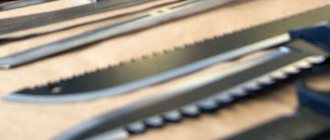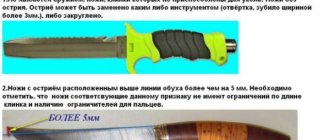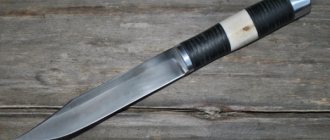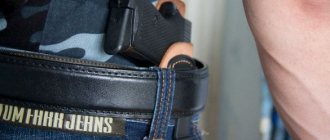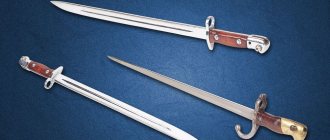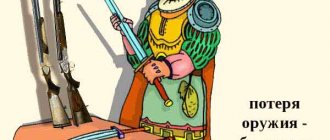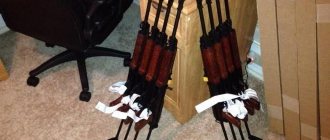This time the dispute flared up in our Northern Fleet. Dismissed from military service due to health reasons, captain of the third rank Sergei Rybak asked the commander of his military unit to issue him a certificate for a bladed weapon - a dagger. He received this dagger about ten years ago after graduating from the naval school with the right to keep it for life and wear it with his military uniform. The commander refused him, saying that he did not have the right to dispose of government weapons. Sergei challenged this in the garrison military court of Severomorsk and won. And the commander filed a cassation appeal against this decision. So the case reached the Supreme Court.
Experts can recognize a knife with a blade length of 90 millimeters or more as a weapon. And a machete with an almost meter-long blade is an entrenching tool
In this particular story, it turned out that in the weapons legislation regarding edged weapons there are very vague rules that allow the same situation to be interpreted differently. But some norms are strictly prohibitive in nature and can bring the owner of a dagger or hunting knife to the dock. And interested officials can interpret this ambiguity to their advantage. This is the very “gray” zone that creates fertile ground for corruption.
And it is also gray because, even when accepting a souvenir blade as a gift, for example, in the shape of a “finka,” the owner cannot be completely sure that he is not breaking the law and will not be prosecuted.
In the situation with the dagger of a dismissed officer, the Judicial Collegium for Military Personnel of the Supreme Court of the Russian Federation discovered inaccuracies in the weapons legislation and sent the case for a new trial to the North Sea Garrison Military Court, but in a different composition of the court.
We don’t know, and it doesn’t matter, what happened between the colonel and the captain of the third rank. There must be something personal. Because the conflict over a dagger seems absurd - tens of thousands of retired officers keep these daggers at home and wear them on holidays. Without any permitting certificates from the last place of service. And no one officially demands from their heirs the return of this weapon even after the death of the owner - all military leaders understand what combat memory is. They themselves intend to keep their daggers, sabers, orders and uniforms in the family. Let descendants remember and be proud. This has happened historically in many countries.
A saber, sword, broadsword, and Cossack saber will be sold to you as an ordinary souvenir. And they will certify this with a certificate. Photo: Sergey Savostyanov
Of course, if not very smart heirs decide to use these relics for criminal purposes. But that's another story.
And the situation is really strange. If Sergei Rybak had not asked the unit command to issue accompanying documents for his dagger, no one would have noticed this - the dagger was issued at the school, not in the unit, it is unlikely that he was listed here. Yes, everyone quits like that! But, on the other hand, the commander is formally right. He didn’t give it out, it’s not him who gave this weapon to anyone. Issuing a dagger is the sole prerogative of the Minister of Defense. Let the military department resolve this situation. And one more nuance: the only really serious obstacle to Sergei’s possession of this dagger is health contraindications - mental disorders, alcoholism and drug addiction. The court did not see these contraindications in the documents presented. But the officer was not sent for medical examinations either.
Most likely, Sergei Rybak will be left with the dagger after he has completed all the necessary exercises - his health has been checked and the consent of the Ministry of Defense has been obtained.
Definition according to the law of the Russian Federation, characteristics, criteria, permissible knife blade length
A bladed weapon is any product related to the hunting, sports or military sphere. At the same time, their action is in no way related to energy carriers and explosives, however, when used, these products can cause a serious injury to a person or cause death.
Article 1 of Federal Law-150 gives a slightly different definition . Thus, the law establishes that edged weapons are a product used to hit a target in close contact with it using muscular force (physical impact).
This type of weapon includes a variety of knives, daggers, sabers and brass knuckles, stilettos and much more. At the same time, the law does not include various household and household appliances, in particular kitchen, garden and pocket knives, in the category of edged weapons.
In accordance with Russian legal principles, edged weapons have the following characteristic features:
- you need special limiters (without them it is difficult to plunge the knife into the target deeply enough and safely for the person wielding it);
- the blade length is over 9 centimeters, it is from this size that the knife can begin to be considered a real weapon; ⇐
- blade thickness – from 0.24 cm;
- the angle of contact of the blade with the butt is less than 70 degrees;
- bending deviation – 0.9 cm;
- characteristics of the minimum hardness of the metal (steel) – 25 Rockwell;
- the depth of penetration of the blade when hitting a target is more than 2 cm. The most striking example here is the checker.
Daggers
If the situation with knives is quite complicated, and it is sometimes difficult to understand which knife should correspond to what, then with daggers the situation is much clearer.
The very essence of the dagger suggests its use as a bladed weapon; it is intended exclusively for piercing blows and is practically unsuitable when used as a household tool. Of course, we may be told that real warriors in the old days could use a dagger to cut bread, kill an enemy, or kill an animal, but we admit the obvious fact: a dagger is a weapon. Unlike a knife, which has a spine and sometimes only partial sharpening on the second side of the blade, a dagger has both edges sharp. This both makes it easier to orient the blade in the hand in extreme situations and reduces resistance when the blade penetrates the target. In Russian legislation, daggers can be both hunting and combat; Occasionally, knives classified as “survival knives” are also allowed to have a dagger blade. All these products are clearly certified as edged weapons. The only exception for a dagger may be the length of the blade: if it does not exceed 89 mm, then such a dagger will not be “cold”.
Do I need a permit, who has the right to carry
The following categories of citizens have the right to carry bladed weapons by law:
- law enforcement officers on duty;
- citizens whose activities are related to hunting;
- athletes for whom owning a weapon is a professional duty;
- retired military personnel who use edged weapons that have trophy status;
- citizens attending thematic cultural events dedicated to weapons (selling antiques);
- users accompanying various cargo during transportation and transportation as a self-defense item.
A permit for bladed weapons will be required in a situation where it does not fall under the category of “civilian use.” If a particular knife has parameters indicating that it belongs to a real weapon, the owner will need to obtain special permission.
Prohibited knives in Russia
FZ-150 establishes a number of functional prohibitions regarding weapons.
The following types of weapons that could be used for civilian and official purposes and are classified as high-risk products are strictly prohibited for circulation:
- stun guns with increased power;
- brass knuckles;
- firearms that imitate the shape of other objects;
- armor-piercing cartridges.
Regarding bladed weapons, the list of prohibited items is much smaller. Thus, knives with automatic opening, as well as objects with a blade length of more than 90 mm, are completely prohibited for free circulation.
Also prohibited are weapons of a throwing nature (surikens, boomerangs), and objects with shock-crushing action.
Is brass knuckles considered a bladed weapon in Russia?
According to the current provisions of the Russian legislative framework, brass knuckles are classified as a special category of edged weapons that have a shock-crushing effect.
Such items are prohibited for sale and carrying on the territory of the Russian Federation, and violators will face criminal liability! Especially severe punishment threatens those for whom the use of brass knuckles is in the order of things.
Large knives and cleavers
Often, when you encounter a large knife in a person’s hands, you can hear exclamations about edged weapons. Is the size of the knife an important factor and which knives should be classified as edged weapons in this case? This is not exactly a case where size matters. As we already know, the length of the blade in edged weapons is not so important - all blades longer than 9 centimeters can meet the required characteristics. However, in the legislation there is such a thing as “hunting cleavers”. These are large knives with a blade length from 150 mm to half a meter; all of them must have a point that provides comfortable and effective piercing blows. These knives are also equipped with impressive crosses, stops or guards. For them, unlike conventional knives, a blade hardness of 40 units is allowed. HRc. These cleavers are used both for finishing off animals and defending against animal attacks, and for performing economic tasks during the hunt, and strict requirements for them are quite natural.
What kind of knife can you carry with you in Russia according to the law, without permission?
The law allows you to carry a bladed weapon whose blade length does not exceed 9 cm. If situations arise where it is necessary to verify the involvement of the weapon owner in a crime, a special examination will be carried out.
At what age can you carry edged weapons?
Federal legislation establishes certain temporary restrictions on the free carrying of weapons. So, if an item has household or economic use, you can wear it from any age.
True, you cannot take it with you to public places, airports, public areas with a large number of people, parades and other cultural events. Although, in the event of problematic issues involving minors, responsibility rests with the parents (guardians).
As for items that fall into the category of edged weapons, they can be worn after reaching the age of 18 and with a licensed license.
Knife handle
This is a fairly broad requirement. First of all, the handle should ensure the owner’s safety from injury when using the knife, that is, eliminate the possibility of the hand slipping onto the blade during a strong stabbing blow. To do this, there are either stops or finger grooves on the handle of the knife. The length of the one-sided stop (limiter), or the total length of the two-sided one, should not be less than 5 mm. The same applies to the depth of the finger groove, if it is present alone on the handle. If there are several such recesses, then the depth of each of them should not be less than 4 mm. Accordingly, if a knife has a simple handle, without stops or recesses, it cannot provide adequate safety for the hand and will not be a bladed weapon.
The above requirements are valid only for those stops and guards that are formed by a separate transverse plate and represent an independent structural element. However, there are handles where the stops are formed by the so-called heel of the blade, that is, the same metal that forms the blade itself. This is often found on slip-mount knives, where the handle and blade are made from one solid piece, with pads on the sides for easy grip. In this case, the length of the supports for edged weapons is still 5 mm, but the thickness of the metal outgrowths themselves should not be less than 3.5 mm to ensure comfort and safety of holding.
How to obtain permission (license) to store and carry
To obtain permission to store and carry weapons, you will need to contact the police department at the citizen’s place of residence. You will need to write a corresponding application and attach a copy of your passport data and 2 passport-type photographs. The applicant must meet only one requirement - to be an adult.
After checking the application, the Department of Internal Affairs makes a decision to issue a license and carries out a procedure such as registration.
The validity period of the permit is 5 years, and upon completion the user is required to get rid of the dangerous item or renew the document.
How to buy a hunting knife legally
For citizens wishing to purchase a hunting knife (a weapon prohibited for the general public), there is a mandatory requirement to register a dangerous item and obtain the appropriate permit from the state.
Using a hunting knife without a permit is a violation and is punishable according to the applicable state requirements.
Hunting knife permit
The law classifies hunting knives as high-risk items. Obtaining a license for a hunting knife is accompanied by submitting an application to the police department at your place of residence and providing an identity card and personal passport-style photographs. The validity period of the permit is 5 years. During this period, the user has the right to buy and store a knife.
If we are talking about a hunting knife, you will also need a hunting association membership card. The knife is assigned a unique personalized number, which is displayed on the ticket. In addition, a detailed description of the weapon is given here.
How to wear and store correctly
The legislator does not establish special rules regarding the storage of edged weapons. It is recommended to keep the dangerous item in a special protective case and store it in a locked place at home, preferably in a safe.
As for wearing, there are even fewer requirements. With a license, the user can legally carry any bladed weapon. An exception would be situations when he visits closed security facilities, airports, public events (parades, concerts, etc.).
Legal aspect
Here the main role is not played by which knife is considered a bladed weapon and which is not. Moreover, in this aspect it may not even be a knife at all, since the legal interpretation of edged weapons only presupposes the capacity in which a particular item was used. And if the item was used as a weapon, then in the eyes of the law it will be such. This aspect concerns one specific subject within one specific action. And since a variety of objects can be used as edged weapons, understanding this interpretation is very important.
Collecting edged weapons in the Russian Federation and its features
Collecting weapons involves their acquisition and subsequent storage or sale . In our country there is a provision (Article 10 of Federal Law-150) according to which an appropriate state license will be required to exhibit collectible weapons.
It is also worth noting that it is strictly prohibited to collect prohibited types of weapons according to GOST standards (throwing blades, shurikens, impact weapons, brass knuckles, stabbing objects), as well as those products whose dimensions exceed the legal requirements (blade more than 90 mm).
Machete
Despite their terrifying appearance, machetes, of course, are not melee weapons. Firstly, they do not have a pronounced point; secondly, the thickness of the blade does not provide rigidity and safety when piercing - often it does not exceed two millimeters. And even the ability to deliver the most dangerous cutting blows does not make such blades a weapon, since, according to legal requirements, edged weapons are intended primarily for piercing, and only then for all other tasks. According to GOST requirements, the blade length for such products starts from 175 mm and, like hunting cleavers, reaches half a meter.
Responsibility for illegal storage, carrying or manufacturing
Regarding violations related to the storage, carrying and production of bladed weapons, the law provides for both administrative and criminal sanctions.
Administrative punishment will be determined, and permissible liability will appear in the form of:
- a fine of 500-5000 rubles (depending on what signs of the offense are identified);
- removal of a dangerous item;
- The administrative code allows for a thorough investigation into the circumstances of the receipt of weapons, as well as their possible involvement in criminal acts.
The punishment under the Criminal Code is much stricter:
- compulsory work for 480 hours;
- correctional labor for 2 years;
- restriction of freedom for 2 years;
- imprisonment for 2 years;
- a fine in the amount of 50-80 thousand rubles or in the form of income for 6 months.
It must be established that illegal purchase of a prohibited product is also punishable.
Types of troops of the Russian Armed Forces
In the Russian army, depending on the location (environment) where combat operations are carried out, the following division into types of troops (forces) has been established:
- Ground troops;
- Navy;
- Aerospace Forces.
Each of them can conduct combat operations, both individually and in cooperation with other branches of the Armed Forces.
The main tasks of the Ground Forces (GF) are classified depending on the situation: in peacetime, during a period of threat and during combat operations.
Ground troops
In peacetime SV:
- maintain combat potential and a high level of training of personnel;
- ensure readiness for operational and mobilization deployment;
- are engaged in preparing control centers and units for combat operations;
- create reserves of weapons, military equipment, and materiel;
- participate in peacekeeping missions;
- take part in eliminating the consequences of accidents, disasters and natural disasters.
During a threatened period, ground forces perform slightly different tasks:
- increasing the number of personnel and increasing the combat and mobilization readiness of troops;
- strengthening forces and means of combat duty, as well as reconnaissance of similar forces of a potential enemy in threatened areas;
- increasing the volume of reserve training;
- participation in certain territorial defense activities;
- preparing weapons and military equipment for combat use, building up the logistics base and the capabilities of repair bodies;
- covering the state border;
- preparation of initial defensive operations.
In wartime, the Army faces the following tasks:
- strategic deployment of the Russian army;
- localization of possible conflicts and defense using units of constant readiness, and, if necessary, reserve units;
- conducting defensive and counter-offensive operations jointly with member countries of the Collective Security Treaty Organization (CSTO);
- participation in repelling enemy aerospace attacks and landings;
- participation in territorial defense.
Navy Parade
The main tasks of the Navy include:
- deterrence from the use of military force or the threat of its use against Russia;
- ensuring the protection of the country's sovereignty, creating and maintaining conditions to ensure the safety of maritime economic activities;
- ensuring Russia's naval presence in the World Ocean;
- display of flag and military force, visits by ships and vessels of the Navy;
- ensuring participation in military, peacekeeping and humanitarian actions carried out by the world community.
In August 2015, the Aerospace Forces were formed by Presidential Decree.
Aerospace Forces
Tasks of the Aerospace Forces:
- repelling aggression in the aerospace sphere and protecting command posts, troop groups, administrative and political centers, industrial and economic regions, the most important economic facilities and infrastructure of the country from enemy attacks;
- defeating enemy targets and troops using conventional, precision-guided and nuclear munitions;
- aviation support for combat operations of other branches of the Armed Forces and branches of the armed forces;
- defeating the warheads of enemy ballistic missiles attacking important government and military targets;
- providing senior management levels with reliable information about the detection of ballistic missile launches and warning about a missile attack;
- monitoring space objects and identifying threats to Russia in space and from space, and, if necessary, countering such threats;
- launching spacecraft into orbit, controlling military and dual-use satellite systems in flight and using some of them in the interests of providing troops with the necessary information;
- maintaining the established composition and readiness for use of military and dual-use satellite systems, means of launching and controlling them, and a number of other tasks.
Latest changes in the law
Amendments to federal legislation on bladed weapons are carried out regularly. The legislator is constantly tightening the requirements for owners of dangerous items.
Among the latest changes affecting Federal Law-150 are:
- Citizens caught poaching will lose their licenses for permitted weapons and will be expelled from the hunting community.
- Users who have more than 2 protocols for non-payment of fines for traffic violations within a year will lose their license and face the confiscation of a dangerous item.
- The possibility of revoking permission for citizens in debt is being discussed. What kind of debt exactly is not yet indicated.
Pros and cons
So, are “cold” knives the most adequate option when choosing? Certainly not. The best knives that we can choose for ourselves will almost never be like this. The main criterion here is not only the scope of tasks, but also legal restrictions on the carrying and circulation of bladed weapons. If household knives have no restrictions on use and purchase, then in the case of edged weapons you should be careful. But then, secondly, we determine what the knife will be used for. And here sometimes compromises are impossible. For example, what knives should perform the function of finishing off an animal during a hunt leaves us with no choice but to turn to extremely effective edged weapons. And some restrictions on its free carrying or acquisition should not repel us, but once again remind us that handling weapons implies responsibility.
Arbitrage practice
Example 1. Citizen A was detained by law enforcement officers with a knife belonging to the “edged weapon” category.
In accordance with the Administrative Code, citizen A was fined 500 rubles, and in addition, a dangerous item was confiscated. Subsequently, the knife will be sold and the amount transferred to the owner.
Example 2. Law enforcement officers detected an attempt to manufacture bladed weapons in artisanal conditions. In addition, a sample of illegal weapons that he had previously manufactured was seized from the suspect.
Criminal proceedings have been opened against the violator, and he was awarded a fine of 50 thousand rubles. Since the offender is the sole breadwinner of the family, a sanction in the form of compulsory work for 480 hours was taken against him.
Example 3. A citizen in the city was detained by law enforcement officers with a knife of unknown origin. The dangerous item was confiscated and the offender was fined. The citizen challenged the actions of the police and insisted on conducting an examination, which should determine the parameters of the product, criteria, etc. The result of a thorough study is that the knife belongs to the category of household use. The citizen was returned his property, and he will have to get back the money paid as a fine. Administrative prosecution has been completely stopped.
Folding or regular?
Another important question is whether to choose folding knives or regular ones. Preference should be given to the first. On the one hand, they are compact - if they are well designed, they will not open spontaneously and will not cause injuries.
On the other hand, they can be carried in a pocket, while one fixed on a belt will attract unnecessary attention and take up too much space in the pocket. Finally, for some reason, law enforcement officers are much calmer about folding knives than simple ones.
At the same time, such a knife copes well with the main functions - you can’t cut up a pig with it, but you can cut sausage, open a can of stew, or sharpen a pencil with it.
